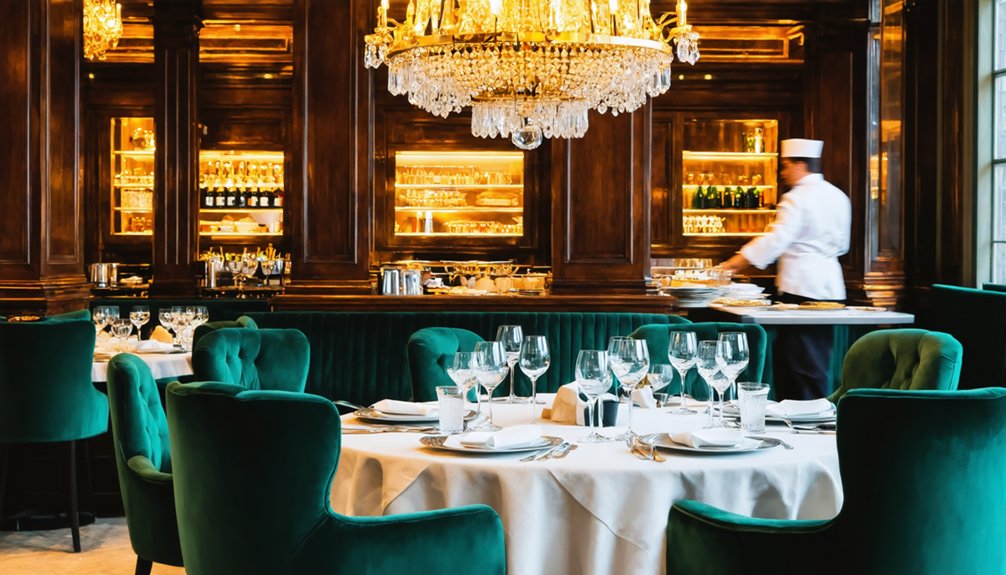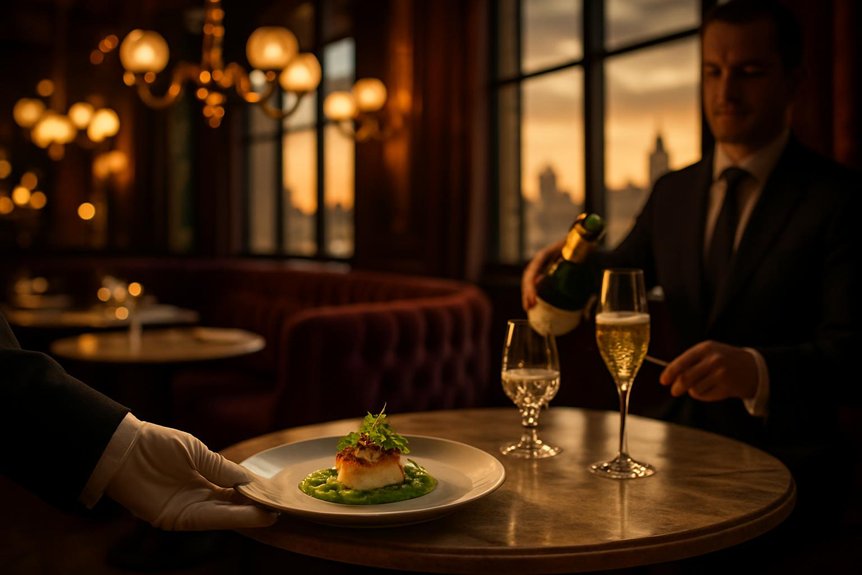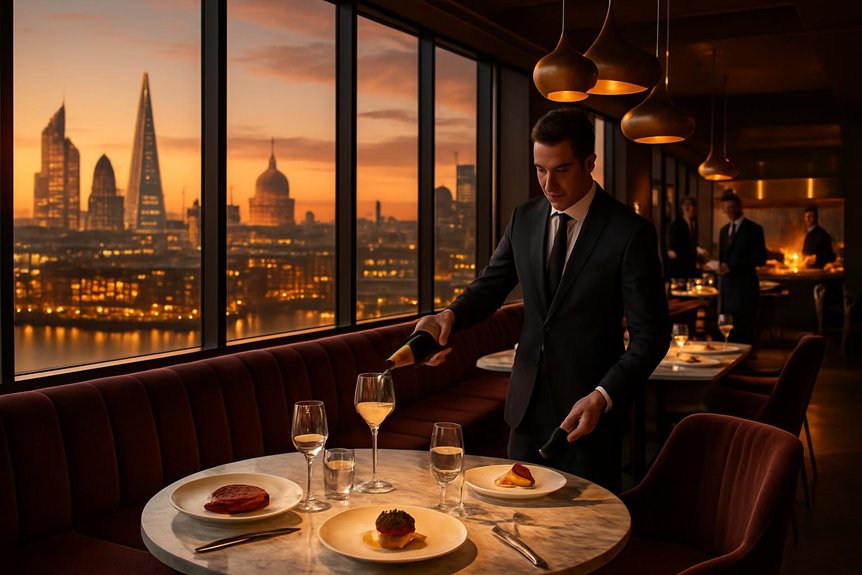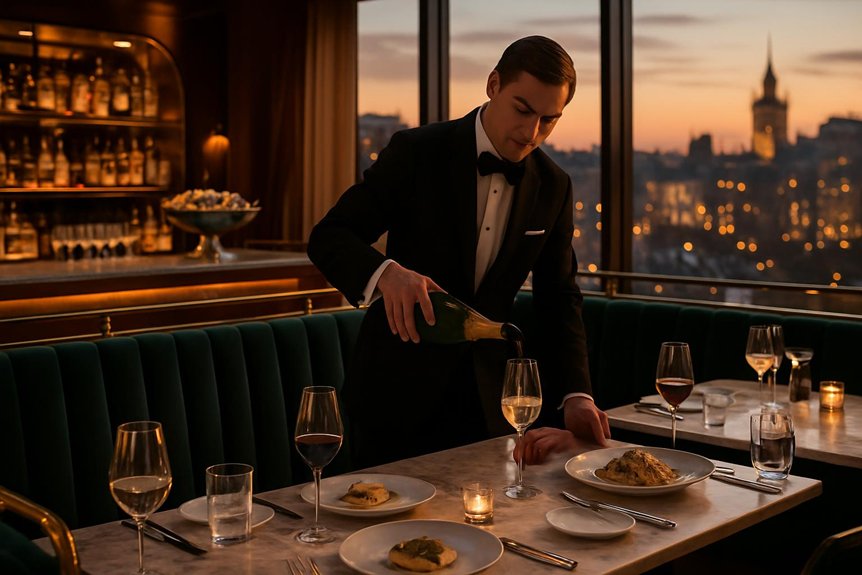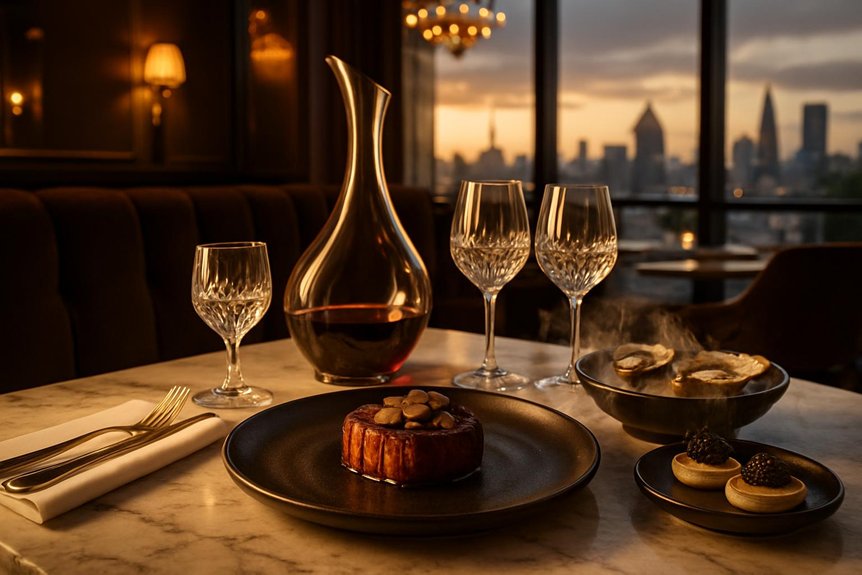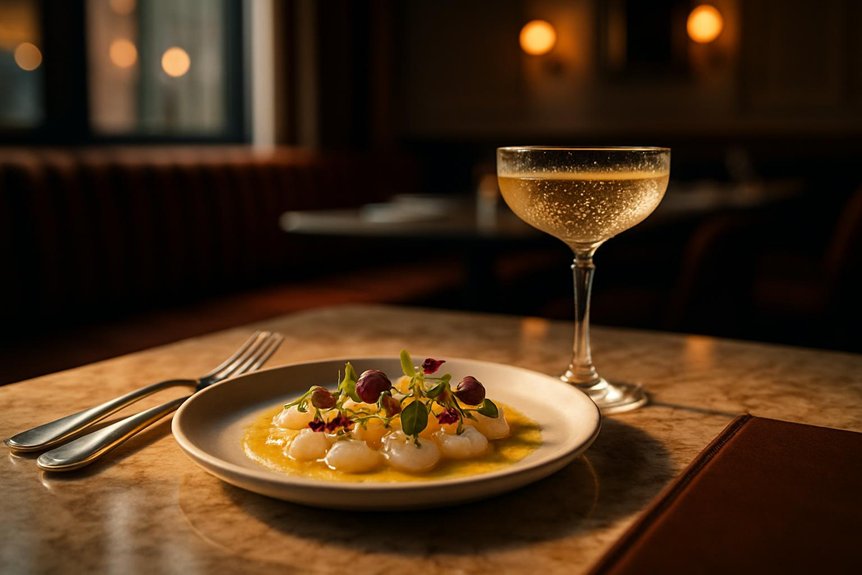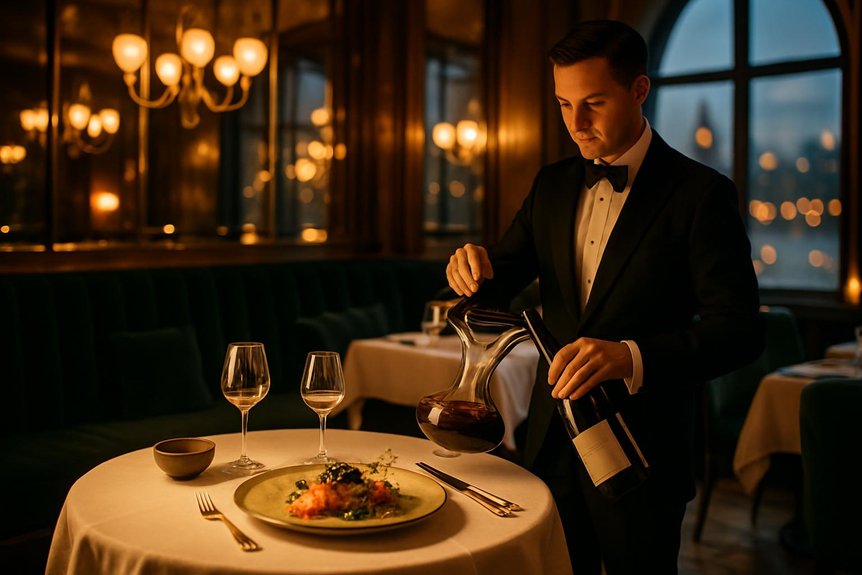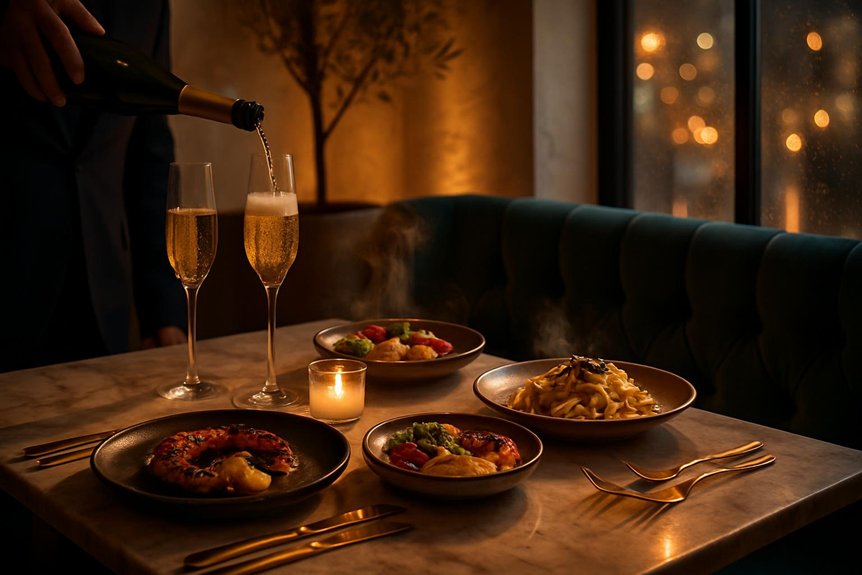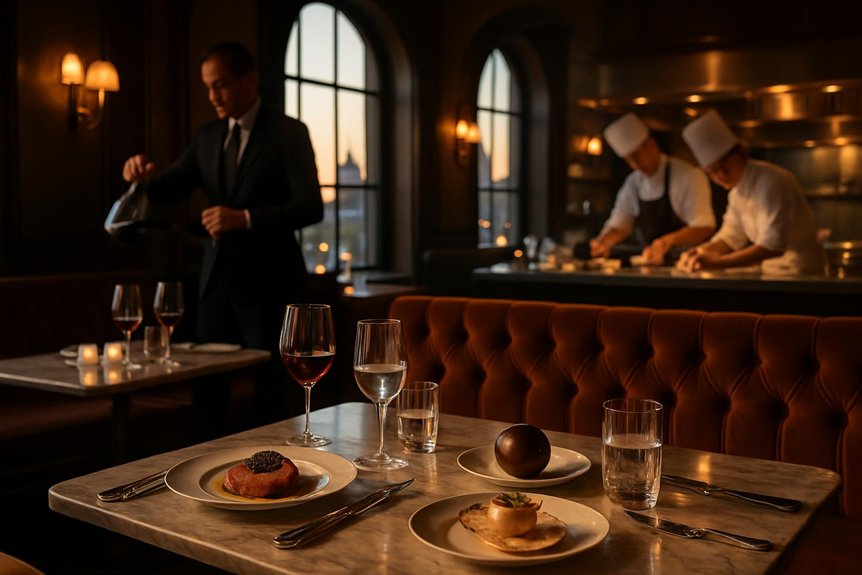London's luxury restaurant scene thrives on a delicate symphony of culinary mastery, innovative experiences, and impeccable service. Michelin-starred chefs transform dining into an art form, crafting personalized menus that captivate the senses. The ambiance enhances flavor perception, creating unforgettable memories. Balancing exclusivity with accessibility, these establishments draw diverse clientele. Yet, what truly sets them apart? The secrets lie in their strategic blend of tradition and innovation, leaving one curious to uncover more.
The Role of Michelin-Starred Chefs in Culinary Excellence
In the domain of fine dining, Michelin-starred chefs are pivotal in setting the benchmark for culinary excellence. These chefs represent the pinnacle of culinary mastery, crafting dishes that transcend mere sustenance to become art forms.
Their influence extends beyond their kitchens through chef mentorship, where they impart their skills and philosophies to the next generation. This mentorship guarantees the continuity of high standards and innovation in the culinary world.
Michelin stars not only signify personal achievement but also elevate the reputation of entire establishments, drawing discerning diners. The rigorous standards these chefs uphold create a ripple effect, enhancing the overall quality of the culinary landscape.
In London, such chefs are integral to the city's status as a hub for groundbreaking cuisine. One such example is the Meraki Luxury Restaurant, where award-winning food and an open kitchen led by celebrity chef Athinagoras Kostakos offer a taste of Greek-inspired excellence.
Crafting Unforgettable Dining Experiences
Amidst the vibrant tapestry of London's culinary scene, the creation of unforgettable dining experiences hinges on a delicate interplay of ambiance, service, and innovative cuisine.
Renowned establishments excel in crafting personalized menus that cater to individual tastes, transforming a meal into a bespoke journey. Each dish tells a story, with chefs weaving experiential storytelling into their culinary creations. This approach not only tantalizes the palate but also engages the imagination, making each visit unique and memorable.
Attentive service further enhances the experience, with staff trained to anticipate and meet diners' needs seamlessly. The result is a harmonious blend of elements that elevates dining to an art form, where every moment is curated to leave a lasting impression.
Adding to this, the intimate atmosphere at Meraki, with its dim lighting and soft music, creates a romantic setting perfect for special occasions.
The Impact of Ambiance on Flavor Perception
The ambiance of a restaurant plays an essential role in shaping diners' flavor perception, and London's luxury restaurants master this art through meticulous sensory design. Carefully curated lighting and mood set the stage for an immersive culinary experience, while acoustic elements subtly influence taste by enhancing or dampening specific flavors. These sensory factors combine to elevate a meal beyond its ingredients, creating a memorable dining experience that resonates with patrons. At Meraki in Fitzrovia, the modern elegance of its setting, complemented by rustic charm and soft ambient lighting, enhances the immersive experience and plays a crucial role in flavor perception.
Sensory Design Elements
While dining experiences often hinge on the quality of food, the ambiance of a restaurant plays an essential role in shaping flavor perception. Sensory design elements, such as color psychology and texture variety, greatly impact how patrons perceive taste.
Colors can evoke emotions and influence appetite; warm tones like red and orange can stimulate hunger, enhancing the dining experience. Conversely, cooler shades such as blue may suppress appetite, subtly altering flavor perception.
Texture variety further complements visual elements, engaging patrons on a multisensory level. Soft furnishings, smooth table settings, and intricate wall textures contribute to the overall ambiance, impacting diners' comfort and focus on flavors.
In London's luxury dining scene, these carefully curated elements elevate the culinary experience, intertwining ambiance and taste.
Lighting and Mood
Although often overlooked, lighting greatly influences the mood and flavor perception in luxury dining. In London's prestigious restaurants, ambiance design plays a pivotal role in shaping the dining experience.
Mood lighting is intentionally curated to enhance the visual appeal and elicit specific emotional responses from diners. This strategic use of lighting can alter the perception of taste, making flavors seem more vibrant or subdued.
Notable elements in ambiance design include:
- Color temperature: Warmer tones create a cozy atmosphere, while cooler hues can add elegance.
- Intensity: Soft lighting fosters intimacy, whereas bright lights energize the setting.
- Focal points: Highlighting certain areas or dishes enhances visual interest and presentation.
These elements collectively contribute to the nuanced interplay between environment and sensory perception, crafting an unforgettable culinary journey.
Acoustic Influence on Taste
How does sound shape the dining experience in London's luxury restaurants? The auditory environment can notably alter how diners perceive flavors. This phenomenon, known as "sonic seasoning," highlights how different soundscapes influence taste.
In upscale establishments, carefully curated soundscapes can enhance the dining experience, making food taste richer or more complex. For instance, soft, classical music might elevate the perception of sweetness, while the sounds of nature could enhance the freshness of ingredients.
Auditory perception plays an essential role in this multisensory experience, as background noise and music tempo can affect how flavors are perceived.
London's top-tier restaurants often enlist acoustic experts to craft sound environments that complement their culinary offerings, creating a harmonious balance between sound and taste to enrich the overall dining experience.
Balancing Exclusivity With Accessibility
Striking a balance between exclusivity and accessibility is a crucial challenge that London's luxury restaurants navigate with strategic finesse.
These culinary havens masterfully blend the allure of exclusive memberships with the appeal of affordable luxury, ensuring a broad yet discerning clientele.
To achieve this delicate equilibrium, they employ several strategies:
- Exclusive Memberships: Offer special privileges to members, ensuring a sense of belonging while maintaining a luxurious aura.
- Affordable Luxury: Introduce select menus that provide exquisite dining experiences without exorbitant costs, making luxury accessible.
- Hybrid Experiences: Create spaces that cater to both private, high-end dining and more casual, open settings.
Embracing Innovation in Traditional Cuisine
In the quest to captivate a diverse clientele, London's luxury restaurants are also redefining traditional cuisine through innovative approaches.
By integrating culinary technology, these establishments are transforming age-old recipes into contemporary masterpieces. Techniques such as molecular gastronomy and precision cooking allow chefs to enhance flavors and textures, offering diners a unique sensory experience.
Furthermore, sustainability practices are at the forefront of this culinary evolution. By sourcing local, seasonal ingredients and minimizing waste, chefs are not only preserving the integrity of traditional dishes but also addressing environmental concerns.
This commitment to innovation guarantees that tradition and modernity coexist, attracting patrons who appreciate both heritage and forward-thinking dining.
Ultimately, these restaurants are pioneering a new era in luxury dining, where creativity and responsibility intertwine.
The Art of Seamless Service in Luxury Dining
While culinary innovation captures the essence of luxury dining, the art of seamless service remains equally essential in defining the experience.
In London's luxury dining scene, service training is meticulously designed to guarantee precision and attentiveness. Staff members undergo rigorous programs, emphasizing every detail to create an exceptional atmosphere. Guest engagement is a focal point, fostering a connection that transcends mere transactions and enhances the dining experience.
The success of seamless service relies on several elements:
- Anticipating Needs: Staff are trained to foresee and address guest desires before they are articulated.
- Personalization: Tailoring interactions based on individual preferences elevates the dining experience.
- Cohesive Teamwork: Harmonious coordination among staff guarantees a fluid and unobtrusive service flow.
In this refined environment, the art of service becomes an integral masterpiece.
Conclusion
As one explores deeper into the mysteries of London's luxury dining scene, a tantalizing question emerges: what truly sets these establishments apart? Is it the mastery of Michelin-starred chefs, or perhaps the artful dance between exclusivity and accessibility? Could it be the mesmerizing ambiance that whispers secrets to the palate? Or is it the seamless service that transforms meals into memories? The answer, hidden within each exquisite bite and experience, awaits those daring enough to discover it.
